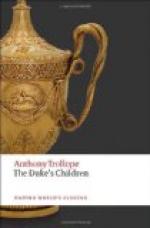At the end of the week there came a visitor to see Lady Mary. A very pretty carriage was driven up to the door of The Horns, and the servant asked for Lady Mary Palliser. The owner of the carriage was Mrs Finn. Now it must be explained to the reader that there had never been any friendship between Mrs Finn and Lady Cantrip, though the ladies had met each other. The great political intimacy which had existed between the Duke and Lord Cantrip had created some intimacy between their wives. The Duchess and Lady Cantrip had been friends,—after a fashion. But Mrs Finn had never been cordially accepted by those among whom Lady Cantrip chiefly lived. When therefore the name was announced, the servant expressly stating that the visitor had asked for Lady Mary, Lady Cantrip, who was with her guest, had to bethink herself what she would do. The Duke, who was at this time very full of wrath against Mrs Finn, had not mentioned this lady’s name when delivering up the charge of his daughter to Lady Cantrip. At this moment it occurred to her that not improbably Mrs Finn would cease to be included in the intimacies of the Palliser family from the time of the death of the Duchess,—–that the Duke would not care to maintain the old relations, and that he would be as little anxious to do it for his daughter as for himself. If so, could it be right that Mrs Finn should come down her, to a house which was now in the occupation of a lady with whom she was not on inviting terms, in order that she might thus force herself on the Duke’s daughter? Mrs Finn had not left her carriage, but had sent to ask of Lady Mary could see her. In all this there was considerable embarrassment. She looked round at her guest, who had at once risen from her chair. ‘Would you wish to see her?’ asked Lady Cantrip.
‘Oh yes, certainly.’
‘Have you seen her since,—since you came home from Italy?’
’Oh dear, yes! She was down at Matching when poor mamma died. And papa persuaded her to remain afterwards. Of course I will see her.’ Then the servant was desired to ask Mrs Finn to come in;— and while this was being done Lady Cantrip retired.
Mrs Finn embraced her young friend, and asked after her welfare, and after the welfare of the house in which she was staying,—a house with which Mrs Finn had been well acquainted,—and said half-a-dozen pretty little things in her own quiet pretty way, before she spoke of the matter which had really brought her to The Horns on that day.




